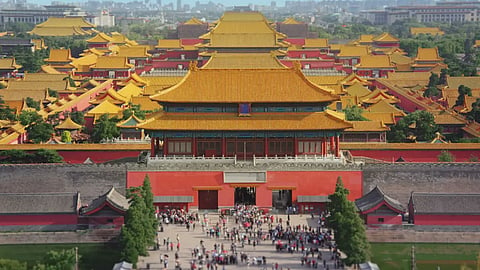The Villa From Under The Tuscan Sun
Buses To Ancient Cities And Forts: 5 Film Locations That You Can Experience As A Traveller
From the March family home in Little Women to the bus in Into The Wild and the fort in Bombay, check out these real life places from your favourite films
The word "Tuscan" is used to depict not just a region in Italy but also used as a lifestyle choice. All thanks to the film Under the Tuscan Sun. Yes, we’re referring to Diane Lane’s 2003 classic. Remember how the film embodied an Italian retreat we all yearned to experience first-hand? For years, viewers lived vicariously through Lane’s point of view, and marvelled at the aesthetics of the property. The film was based on a book (of the same name) written by Frances Mayes. The 1996 book was a memoir about her experience restoring an abandoned villa called Bramasole in the Tuscan countryside. The book was on various bestseller lists for more than three years. So we know who to blame for the world's Tuscan lust. If you have watched the film and like Diane Lane, hankered after the idea of vacationing in Under The Tuscan Sun’s Villa Bramasole, your dream is about to be realised. What if we told you that Bramasole transcends the sets of the film, and awaits your arrival?
Nestled in the fringes of Cortona, Villa Laura, alias Villa Bramasole, has resurrected its much sought-after charm, and departed from its ruin-like condition following a complete restoration undertaken in 2006. Built in 1805, the villa reflects a streak of opulent style and retains old-school sensibilities distinct to the Tuscan countryside. The property also extends into a rustic farmhouse, initially used for housing animals and farm-workers, and a limonaia meant for storing citrus fruits during winter. Easily connected to other destinations, the villa promises a six-minute-drive to Cortona, an additional few minutes to the beach at Lake Trasimeno, and is positioned an hour-and-a-half from Florence. So go ahead and assemble your own Under The Tuscan Sun moment into a week-long holiday.
The Bus From Into The Wild
The infamous bus where Chris McCandless breathed his last is now a part of the Alaska Museum. Popularised by the book Into The Wild by author Jon Krakauer which was later made into a full length movie by Sean Penn, the site had attracted many curious adventure lovers and hikers over the years. Alaska's Department of Natural Resources (DNR) has relocated the vehicle to a museum in Fairbanks, Alaska.
Chris McCandless hitchhiked to the Alaskan wilderness where he found this abandoned bus and made it into a makeshift shelter in 1992. He had gone to the site with limited supplies but tragically could not return due to the swollen Teklanika River. He lived in the bus 250 miles north of Anchorage and kept a journal of his plight and hardships. Though still a topic of debate, it is believed McCandless died due to starvation. The body was later discovered by a local hunter from the area.
Since then, the eerie spot has become a pilgrimage for most adventure lovers who tried to recreate McCandless’ steps. Unfortunately some have lost their lives. Many search-and-rescue missions were also carried out by the authorities.
The March Family Home from Little Women
Loved watching the feisty Jo March and staring at Timothee Chalamet’s ungodly jawline? Sighed as winters and spring unfolded (on screen) in the New England countryside, with books and balls sprucing up evenings? So did thousands of fans across the world. 2019’s Little Women is the sixth film adaptation of Louisa May Alcott’s endearing novel, and viewers are hungry to dig deep and find out more about the family that inspired the film. Orchard House, the March family home, is where most enquiries are currently headed. Many aren’t aware that the location is an actual heritage monument in Concord, Middlesex County, Massachusetts.

The original home of writer Louisa May Alcott, Orchard House is a 12-acre manor where she set and finished her seminal novel, basing it off her own family life. Most of the furnishings—around 80 per cent—are just as they were when the Alcotts first lived there, with careful preservation ensuring the rustic ambience doesn’t change anytime soon. Visitors find it’s like instantly wading into the film.
The Forbidden City in Mulan

The King’s palace in the film Mulan has drawn inspiration from the largest imperial palace in the world, The Forbidden City in Beijing. Built in the early 15th century, the complex housed the emperors of the Qing and Ming dynasties for over 24 generations and comprises of 980 buildings and 90 palaces and more than 8,700 rooms. Hosting 14 million tourists every year, the city was once “forbidden” for the ordinary people, thus the name.
The Fort From Bombay

Remember 'Tu Hi Re' from the movie Bombay? The Mani Ratnam film had a stunning setting in Kerala for this gem, with a fort facing the sea and continuous rain. The scenes where Aravind Swami sang his heart out were set in the beautiful Bekal Fort in Kerala. Overlooking the big waves in the Arabian Sea and providing a mesmerising view with a well-manicured garden on the periphery, the fort is indeed a stunner. Standing at a height of 130 feet from sea level, the gigantic fort built by Tipu Sultan is the largest in Kerala. With cannons and other artifacts from the Sultan’s era still intact, the fort is one glorious blast from the past. Visit during the monsoon to replicate the scenes from the iconic song.